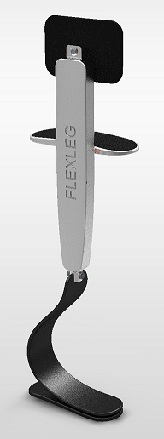The Flexleg is a device to provide hands-free temporary mobility assistance to a user with lower leg injuries that can be treated without a cast, such as sprains. It draws on some of the technology used in today's prosthetic design and construction, including a frame made from the same aluminum as is used in modern aircraft, and a "foot" made from flexible shock absorbing material. Instead of placing the knee into a cup at the top of the prosthetic, the user rests it on a padded shelf attached to the side of the frame, straps it to his or her thigh, and is ready to take a walk or even go for a run. The injured limb is held out of the way, preventing it from touching the floor or ground.
Since no crutches are needed, the FlexLeg enables its user to return to activities of daily living more quickly and with fewer inconveniences. For example, a student can seat him or herself anywhere in the tight spaces of a lecture hall instead of having to compete for an aisle seat, or be able to carry books or other items as easily as they would have before the injury. While crutches or a knee scooter would prohibit or complicate climbing stairs or walking on irregular or uphill terrain, the direct interface between the FlexLeg's foot and the floor or ground allows the user to negotiate almost normally. The hands are left free, permitting the user to carry objects, talk on a cell phone while walking, or cook without having to negotiate with crutches, keeping the user close to the same level of independence. However, a doctor or physical therapist may recommend a cane for additional support, such as in the case of an elderly patient.
With the upper body freed from the task of supporting the weight while using the crutches, there's a reduced need for concern about aggravating injuries to the hands or shoulders that may have been incurred along with injuries to the lower body, such as in a fall or a car accident. Several mechanical engineering students at Brigham Young University were inspired to develop the FlexLeg after seeing pictures of athletes using the new generation of prosthetic limbs with the shock absorbing feet. They wondered why a similar device couldn't be developed to assist people recovering from lower body injuries. FlexLeg has received coverage in Popular Science and Wired magazines as well as several science and design blogs such as DesignBuzz and Idea Connection. The FlexLeg won second place in Brigham Young University's business plan competition, second place in the University of Utah's techTITANS competition, second place in Wake Forest University's Elevator Awards for traditional marketing and their fan favorite award, and participated in the University of Oregon's NVC trade show.
Fran Jablway
and
Hulet Smith, OT